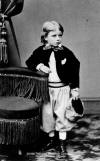 |
Four year old "Teedie" Theodore Roosevelt in 1862. TR suffered
greatly from asthma causing him to be sick frequently. |
 |
At at eleven Theodore visited Paris where this photo was taken in
1870. At
first his illness (asthma) kept him from strenuous exercise. Later
he would "make his body" and become strong. |
 |
About eighteen years old Theodore Roosevelt (top left) with brother
Elliott, sister Corinne and family friend Edith (who would later
become his second wife). The look of the eyes and the brow are the
same, but the body of TR here, around 1876, is now much stronger,
the product of a home gym his father had created for him. |
|
Now a young man, Theodore Roosevelt began his "classroom" education
at Harvard, in Cambridge Massachusetts. His early schooling had been
primarily from a governess in individual or small group settings. As
a boy Roosevelt had attended school for a short period, but his
health prevented normal schooling for much of the time. At Cambridge
he would meet some life long friends and colleagues. [Dec 1876] |
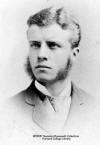 |
|
TR had become quite athletic by the time he reached Harvard. Here he
appears in his sculling outfit. Rowing and boxing were two of the
"organized" sports in which TR participated. When skating with
friends, Theodore was still out on the ice long after everyone else
had quit from cold and fatigue. [circa 1877] |
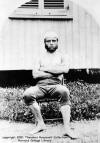 |
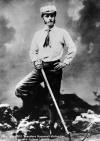 |
During his 1881 wedding trip to Europe with first wife Alice
(Hathaway) Lee Roosevelt, TR climbed the Matterhorn. He considered
the climb acceptably strenuous, and was pleased with himself for
making the trek. As was the custom of the day, this photo was taken
in the studio to commemorate the trip, not actually on the mountain.
Stunned with the
mix of grief and joy over the death of his mother Mittie and his
wife Alice on the same day in the same house combined with the birth
of his first child, daughter Alice, two days before, TR retreated to
life in the western Badlands of Medora, North Dakota. |
|
There he would heal and learn lessons that would shape not only his
future, but the future of the nation. Working shoulder to shoulder
with all kinds of men in the west he said, "took the snob" out of
him. Working the ranch brought about a profound love of the open
land, unique geography and animal species that were fast
disappearing with increased settlement and development. [ca.1885] |
 |
|
Ten years later we find TR in Washington married to his long time
friend Edith. Quentin was not born yet so there were 5 children
under the roof. By this time in 1895 at the age of 36 TR had already
had more careers than many men. He had been a Legislator in New York
State, a rancher, and the author of several books and was now Civil
Service Commissioner. |
 |
|
From 1895 to 1897 TR and family would be back in New York City,
where TR became President of the NYC Board of Police Commissioners.
Although he sits at a desk here, TR was famous for prowling the
streets at all hours learning more about the police as well as the
worst corners of the city. He greatly reduced corruption, increased
the use of technologies and created one of the first academies for
police training. |
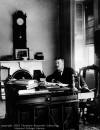 |
|
While keeping watch of NYC crime, TR also kept his eyes on the
world. After two years he was back in Washington, this time as
Assistant Secretary of the Navy. |
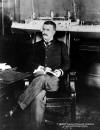 |
|
In 1898 TR raised a volunteer regiment which included cowboys and
schoolboy (typically college athletes) as those who knew him from
various times in his life joined to fight the Spanish in Cuba. On
July 1, 1898, the
Rough Riders would play a critical role on Kettle Hill and San
Juan Hill during the battle of San Juan Heights. TR lead one charge
on horseback and one charge on foot, inspiring his troops but
exposing himself to enemy fire. 103 years later he would receive the
Congressional
Medal of Honor for his bravery that day. |
 |
|
In addition to loss of life in battle, the soldiers faced the rages
of malaria, yellow fever and dysentery. Colonel Roosevelt was a
volunteer, not regular career army, so it was he who made the plea
to Washington's leaders on behalf of the men.
Bring them home! His Rough Riders returned to quarantine in Camp
Wikoff, Montauk, Long Island. [Aug - Sept 1898] |
 |
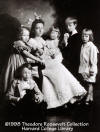 |
The press coverage of the charismatic character "Rough Rider
Roosevelt" propelled TR back into politics, now to be Governor of
New York State. By now there were six children. The oldest, Alice,
holds baby Quentin on her lap in this 1899 family portrait.
|
|
By 1900 a corrupt "Easy Boss" Tom Platt was anxious to get TR out of
New York State and recommended him for the Vice Presidency. TR's
fame from the Rough Rider days and Platt's political maneuvers
easily won Roosevelt the nomination. In the prior election, William
McKinley ran with running mate Garret Hobart (VP 1896). The
shrubbery is dark where Hobart was replaced with Theodore Roosevelt
to create the new photomontage. |
 |
|
Without television campaigning was very different in 1900. McKinley
rarely traveled during the election campaign, that was not
considered appropriate for a President, but TR was out all over the
country, making speeches for the Republican ticket and meeting the
public. |
 |
|
When President McKinley was shot at the Pan American Exhibition in
Buffalo, NY in 1901, TR became the youngest person ever to become
President. He was only 42.
As President
Theodore Roosevelt he continued to be a very visible and traveled
leader shown here on a New England tour in 1902. |
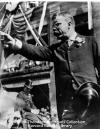 |
|
September of 1902 found TR speaking in Asheville, North Carolina. |
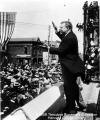 |
|
The famous bear hunt in 1902 would forever link
Theodore Roosevelt and the "Teddy" bear in political cartoons,
children's stories and toys. The bear hunt had been unsuccessful and
the guides and dogs captured an old female bear and tied it to a
tree for the President to get "his shot". TR refused. Political
cartoonist Clifford Berryman captured both the sportsmanship and the
politics of the day in his cartoons. |
 |
 |
This 1903 photo shows the President, his wife Edith and their six
children at the family home of Sagamore Hill in Oyster Bay on Long
Island, New York. TR loved his family and spent hours roaming the
hills and rowing the shores with the children. |
|
President Roosevelt in the White House. [1903] |
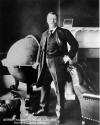 |
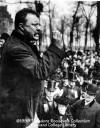
|
Theodore Roosevelt considered the Presidency a "bully pulpit", a
good place from which to make a statement to the public about the
way things ought to be. All the time he had spent learning about how
people lived from the ranchers and small farmers in the west,
tenement dwellers and shop keepers in the city, and soldiers in
battle helped him identify with ordinary citizens from all walks of
life. Here he speaks to an audience in Evanston (near Chicago) in
1903. |
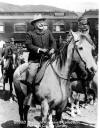 |
Roosevelt started his efforts to preserve Yellowstone National Park
as early as 1894 when he as president of the Boone and Crockett Club
(a hunters' organization comprised of eminent scientists, lawyers
and politicians) worked the Secretary of the Interior to enlarge the
park and improve its governance. The resulting legislation provided
new levels of protection from commercial development and "ecological
destruction".
Conservation of natural wonders and natural resources became
TR's legacy. In 1903, President Roosevelt came to inspect
Yellowstone. |
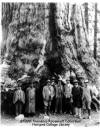 |
Can you imagine a tree so big that a whole group of grownups looks
so tiny? Here we find President Theodore Roosevelt with naturalist
John Muir at Yosemite in 1903. |
|
"There can be nothing in the world more beautiful than the
Yosemite, the groves of giant sequoias and redwoods, the Canyon of
the Colorado, the Canyon of the Yellowstone, the Three Tetons; and
our people shoud see to it that they are preserved for their
children and their children's children forever, with their majestic
beauty all unmarred." Outdoor Pastimes of an American Hunter 1905.
|
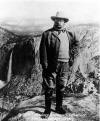 |
|
One of the most critical parts of US defense was a strong Navy, and
a Navy which could be quickly mobilized to protect either the
eastern or western coastal waters. The building of a canal on the
isthmus of Panama would be critical to the strategic strength of the
United States. Here TR inspects the canal construction in Panama in
1906. |
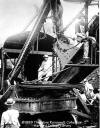 |
|
The demands of the Presidency made vacation travel difficult. Edith
took charge of finding a retreat for the family in this simple cabin
in the woods of Albemarle County, VA. The rustic hideaway had no
running water. Son Archie took on the task of fetching water when
the family visited. [ca. 1906] |
 |
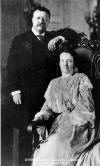 |
President Theodore Roosevelt and First Lady Edith Roosevelt in 1908. |
 |
The Roosevelt's leaving the White House in 1909. Nicholas Longworth
who married Alice in 1906 appears at the far right. |
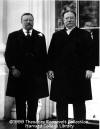 |
Theodore Roosevelt with incoming President William Howard Taft on
Taft's inauguration day in 1909. Roosevelt picked Taft to be his
successor in the Republican party and endorsed his election as
president. Roosevelt left the White House believing that Taft would
continue activist progressive policies as the new President. Such
was not to be the case. |
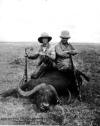 |
Still only 50 years old when he left the Presidency, TR went looking
for adventure on Safari in Africa. At heart TR was a naturalist,
fascinated with all the species of animals on earth. He always had a
small menagerie of live and preserved specimens as a child. As and
adult he was quite expert. Hundreds of species were identified and
brought back to the Smithsonian and the American Museum of Natural
History from his 1909-1910 expedition to East Africa with son Kermit
(shown sitting next to TR). |
|
News of trouble at home was beginning to reach the former President.
Conservation and tariff policies were dividing the Republican party
and the "Old Guard" of conservatives were taking control. |
 |
 |
Reporters were waiting as TR, Kermit and their party ended the
safari and arrived in Egypt. TR, joined by Edith began a "grand
tour" of Europe including Paris, where he delivered his "Citizenship
in a Republic" speech and Norway, where he accepted the
Nobel Prize he had been awarded several years before for the Treaty
of Portsmouth. |
|
TR reviews the German Army maneuvers with Kaiser Willhelm II during
another stop on the grand tour. The Kaiser gave TR photos of the
occasion, personally writing inscriptions on all of them. A few
years later Germany would invade Belgium at the start of WW1. When
the German embassy conveyed a message to TR that recalled his
pleasant visit TR replied, "I shall never forget the way in which
His Majesty the Emperor received me in Berlin, nor the way His
Majesty King Albert of Belgium received me in Brussels." |
 |
|
TR lost the election of 1912 when he ran for President on the
Progressive "Bull Moose" ticket, splitting the Republican vote and
handing the election to Democrat Woodrow Wilson.
1913, Theodore
Roosevelt at the wedding of his daughter Ethel to Richard Derby. |
 |
|
In 1914 TR
decided to make a lecture trip to South America. Only a small amount
of exploring was initially planned. Once in Brazil, however, plans
were formed to explore an unmapped river, the River of Doubt which
flowed from the interior to the Amazon. Colonel Rondon (right) and
Colonel Roosevelt along with Kermit and about 20 others began the
journey. |
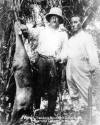 |
 |
The expedition members faced insects, floods, hostile natives and
capsizing canoes. Several members of the party were lost including
one who went insane and killed another before running off into the
jungle. Kermit who had postponed his wedding to join his father on
the trip nearly died when he was swept over a falls. |
|
Theodore lost 57 pounds during the journey and nearly died from
malaria and dysentery. After a major exploration of 1500 miles they
had acquired a significant collection for the American Museum of
Natural History. |
 |
| A
much older Roosevelt returned from Brazil to fight for US entry into
the war. Roosevelt firmly believed in the need for a well prepared
army and navy particularly in light of German aggression against
Belgium, France and Britain and potentially the US. He worked hard
but from the sidelines. Here in Sept of 1915 he has made a visit to
Quebec. [with guide] |
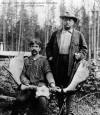 |
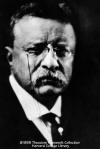 |
Former President
Theodore Roosevelt, 1915. |
|
1916 |
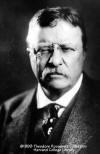 |
| TR learned
of the death of his youngest son Quentin in July of 1918. Quentin, a
fighter pilot for the US Army Air Corps in WW1, was shot down behind
enemy lines.
"Grandfather"
Roosevelt hugs baby granddaughter Edith Roosevelt Derby, 1918. |
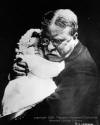 |
 |
Archie sent a cable to his brothers, "The old lion is dead."
Roosevelt died in his sleep in the "Gate Room" at Sagamore Hill
early on the morning of January 6, 1919 from a pulmonary embolism.
Photo shows the burial of Theodore Roosevelt, January 1919 in Youngs
Memorial Cemetery, Oyster Bay, NY |

